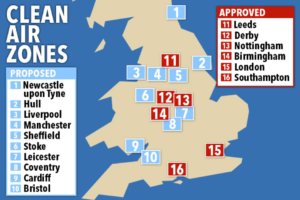Clear Air Zones UK – Good News Or Bad News?
Clean Air Zones (CAZ) are areas in the UK that have been introduced by local authorities to improve air-quality by introducing fees for drivers. In a daring bid to reduce emissions, Clean Air Zones were first proposed in 2015, and have finally come into force this year. They fit into the UK’s target to be at almost a “net zero” emissions rate by 2050.
Originally, the UK was set a target to reduce their emissions by 80%. In 2019, they decided to do one better and announced that their revised goal was to achieve a “net zero” status, meaning they wish to eradicate emissions completely from homes, industries and transport in 30 years.
But are Clean Air Zones good news or bad news? Let’s think about the logistics industry and how CAZ may affect it.
How Will Clean Air Zones Affect The Logistics Industry?
There’s no argument that cleaner air is a universally desired outcome, we are all working towards creating an eco-friendlier environment with nearer to no emissions. However, are Clean Air Zones the best way to approach this?
It was recently announced that CAZ restrictions will be applied to non-compliant private vehicles. That’s as well as buses, taxis and most importantly HGVs – who’ve already been told that the charge will affect them. This latest development was big news for those following the evolution of this scheme, but for HGV drivers and logistics workers, ever since Clean Air Zones were first considered in 2015; we’ve always known they were to have some effect on our industry.
Clean Air Zones – How They’re Bad News
The government has made a bold statement that they not only plan to reduce emissions by a percentage by 2050, but rather strive for “net zero” status by this date. It is, of course, going to take some significant changes to accomplish this, and Clean Air Zones are just one contributing solution.
However, they are set to crucially impact the logistics industry and how it operates.

Image credit: Arrow Self Drive
Charges Could Have Financial Implications On The Logistics Industry
The charges are set to be steep for large vehicles such as HGV’s, with most fees ranging from £50-£100 per day depending on the city. The transport and logistics industry is crucial for the safe passage of goods from one place to another, and without HGV drivers, the world we’re used to would look rather different. These crippling charges are set to seriously impact the logistics industry and its revenues, which in turn could create a ripple effect wherein the distributions of goods are delayed, and services are impacted.
The Problem Could Be Worsened With Longer Driving Routes
Cities that are operating CAZ such as Birmingham, Leeds, Nottingham and London may find the problem becomes exasperated, rather than eradicated. It has to be assumed that some, who would like to avoid the fine, may choose alternative routes and accumulate more mileage. Therefore, outputting even more emissions. By actively discouraging drivers from entering these major areas, we’re left to wonder whether the knock-on effects could actually be worse than the situation as it is now, with increased fuel consumption and increased out-of-city traffic?
Vehicles On The Road Could See An Increase
We questioned back in November that if some areas replaced trucks with vans (as several local authorities are proposing in an effort to reduce emissions), will this end up increasing the number of vehicles on the road, along with their congestion and emissions? HGVs play an essential role in the national economy – irreplaceable in some respects. The largest truck can carry the load of 20 vans. Could disrupting the system we have in place now with introductions such as Clean Air Zones have adverse effects?
Clean Air Zones – How They’re Good News
By the same token though, we at the Barnes Group are committed to assisting the Government with their “net zero” emissions target and understand that re-evaluating the way the logistics industry operates has a vital part to play in this. Here are some reasons that we endorse the introduction of Clean Air Zones.
Certain Vehicles Are Exempt From CAZ Fees
Plus, not all vehicles will be subject to CAZ charges; compliant vehicles can enter zones free of charge, for HGV’s this includes Euro 6 engines, which are defined by all vehicles with 14 plate or newer. Buses and coaches that meet Euro VI emission standards, as well as cars, vans and taxis that meet Euro 6 (for diesel engines) or Euro 4 (for petrol engines) are also exempt, that’s as well as any ultra-low emission vehicles with a significate zero-emission range.
Clean Air Zones Work As Good Deterrents
There’s no doubt that Clean Air Zones will work well as a strong deterrent, resulting in some drivers avoiding major areas that are suffering from build-up. With this in mind, the idea of discouraging motorists in this way seems to be effective. We’re certainly an advocate of persuading individuals not to drive through populated areas when there’s no reason for them to do so.
However, this does leave us to wonder whether there are other means by which drivers could be motivated. Would the ‘carrot’ approach work better than the ‘stick’?
Ultimately, for the logistics industry, introducing extortionate fines only looks to cripple the sector financially. Is it fair to punish companies for simply operating as standard? It would be near impossible to halt HGVs driving through major cities completely, as every single one of us relies on logistics in our day-to-day lives. Without drivers such as ours at the Barnes Group, we’d all live a very different lifestyle.
Is there a better way to tackle the emissions crisis together, rather than working against one another?
Let us know your thoughts, or just keep up with what we’re doing on Twitter.
You can check whether your route will be effected by Clean Air Zones (CAZ) by clicking here.

















